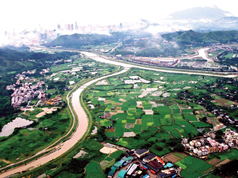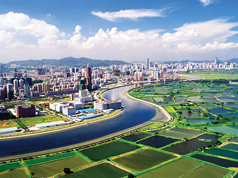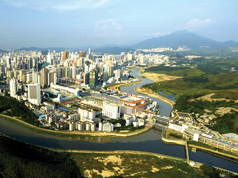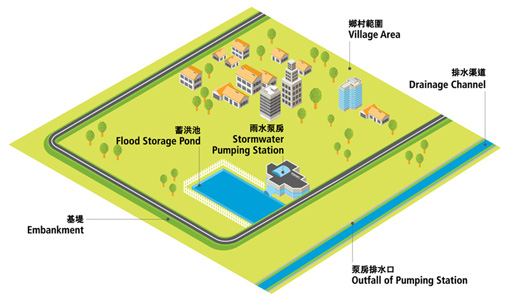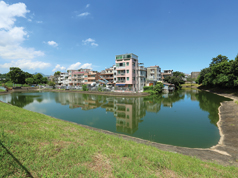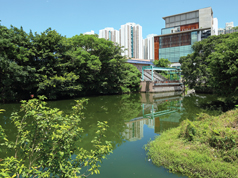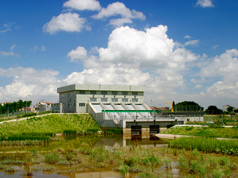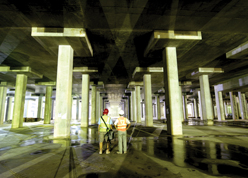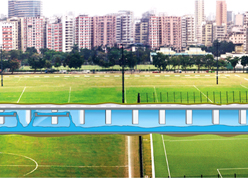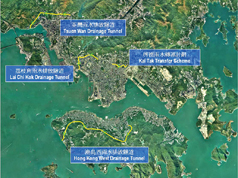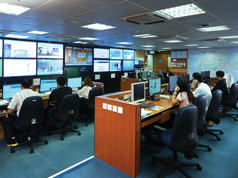Overview of Flood Prevention
Hong Kong is vulnerable to flooding due to heavy rainfall. The mean annual rainfall of Hong Kong is about 2,400 millimetres, one of the highest amongst the cities in the Pacific rim. Heavy rainfall, coupled with storm surges during the passage of tropical cyclones, can cause flooding to low-lying areas and those with inadequate drainage systems. With a mission to safeguarding the general public against flooding, we commit to ensuring the drainage system being continuously maintained in good condition and to world-class standard.
During the past years, we have implemented a series of flood prevention projects to enhance flood protection level and reduce flooding risks of different districts. We are now conducting Drainage Master Plan (DMP) Review studies for different regions in phases, and formulating drainage improvement strategies to cope with the city's rapid development and changing drainage needs.
Completed Shenzhen River Regulation Projects Stage I, II & III
Operation and Maintenance of Existing Facilities
Our Department carries out routine inspection and regular preventive maintenance works to the stormwater drainage facilities to ensure them functioning as designed.
Engineered Drainage Channel
To mitigate the flooding problem in the New Territories (NT), since our establishment, our Department has launched a series of river training works, which involve straightening, widening or deepening of existing watercourses to increase drainage capacity and enhance the flood protection level of the relevant catchment areas. Most of the river training works in NT have been completed. The remaining river training works focus on the upstream areas, including Regulation of Shenzhen River Stage IV.
Village Flood Protection Scheme
Our Department is maintaining 27 village flood protection schemes which provide adequate flood protection to and effectively reduce the flooding risks of 35 low-lying villages since commissioning.
In general, a village flood protection scheme involves the construction of an embankment to separate the existing low-lying village from the surrounding land and to prevent external runoff from entering the village, a flood storage pond for temporary storage of stormwater within the bunded area during heavy rainstorms and a stormwater pumping station to pump water from the storage pond to an outside channel after rainstorms.
The village flood protection schemes are designed for unmanned automatic operation. Therefore, we have to conduct regular inspections of the floodwater storage pond and drainage channel, and testing and trial operations of the pumping station Telemetry devices have also been deployed to ensure proper upkeep and operation of the scheme.
Stormwater Storage Scheme
Stormwater storage scheme is often adopted when the capacity of the downstream drainage network is inadequate to cope with the increased peak flow rate arising from the developments at upstream areas. When the upstream areas are being developed and the downstream areas have already been fully urbanised, the conventional method of upgrading the existing drainage network at the downstream busy roads will cause severe disturbance to the traffic and public, not to mention congested underground utilities that would cause great constraint to drainage construction. The principle of stormwater storage scheme is to temporarily store stormwater during heavy rainstorm in an underground tank, thus relieving the burden of downstream drainage system. When the stormwater in the downstream drainage system recedes, the stormwater stored in the tank will be pumped out to regain stormwater storage space for the next rainstorm. The stormwater storage schemes at Tai Hang Tung and Sheung Wan have successfully reduced the flooding risks in Mong Kok and Sheung Wan respectively.
Drainage Tunnel
Stormwater drainage tunnel system is constructed to intercept and divert stormwater runoff from upland areas for direct discharge to the sea or river. By employing this method, less stormwater from upland areas would enter into the existing drainage systems in the downstream urban areas. Therefore, the flooding risk of the downstream urban areas could be reduced without resorting to extensive drainage upgrading works that would cause disturbance to the traffic and general public.
Currently, our Department is maintaining four drainage tunnels namely Kai Tak Transfer Scheme, Hong Kong West Drainage Tunnel, Lai Chi Kok Drainage Tunnel and Tsuen Wan Drainage Tunnel with a total of about 22 kilometres long over the territory. The commissioning of these drainage tunnels has significantly reduced the surface runoff flowing into the downstream urban areas including Sheung Wan, Central, Admiralty, Wan Chai, Causeway Bay, Mong Kok, Lai Chi Kok, Cheung Sha Wan, Sham Shui Po, Tsuen Wan and Kwai Chung and hence has significantly increased the flood protection level and alleviated the flooding risk of these areas.
Stormwater Drains
To ensure proper functioning of the drainage system, we conduct both functional and structural checks on a regular basis to identify problematic stormwater intakes, drains and watercourses and carry out maintenance and repair works promptly, especially before and during the rainy season. In 2012-13, over 2,000 kilometres of stormwater drains and watercourses were inspected.
Emergency and Response
In addition to routine operation and maintenance, we have established an "Emergency and Storm Damage Organisation" (ESDO) to handle emergency and flooding problems all year round. Under the ESDO, an Emergency Control Centre overseen by senior professionals will be activated when the situation warrants in order to coordinate emergency clearance of blocked drains and watercourses throughout the territory, to respond to flooding reports, and to disseminate information within the Government and, where necessary, to the public.
Planning, Design and Construction of New Works
Review of Drainage Master Plan (DMP)
Our Department has been proactive in commissioning drainage studies and implementing flood prevention projects to protect the general public against flooding. Since our establishment in 1989, we have completed eight DMP studies and three drainage studies covering the flood-prone areas of the territory as well as completing a series of drainage projects to meet the flood protection level of different districts.
To cope with the latest developments in the community and the climate change impact on drainage system, it is necessary to timely review and update the DMPs, and devise strategies to cope with the city's increasing drainage service needs. Our Department has commenced the review studies for DMPs of different regions in phases. Comprehensive review and evaluation of the completed drainage improvement works recommended in the DMPs will be conducted under the review studies. Further improvement measures would be recommended and implemented as necessary.
The first review study for DMPs in Yuen Long and North District was completed in 2011. To ensure sustainable development of Kowloon and to keep up with the large-scale projects in the region, we embarked on the review studies for DMPs in West Kowloon and East Kowloon in 2012 for completion in 2014. We also started the review studies for DMPs in Tai Po, Sha Tin and Sai Kung in 2013 for completion in 2015. Similar DMP review studies for the remaining drainage catchments will progressively follow in the coming years to cope with the increasing drainage needs.
Porous Pavement Design in Future Drainage Master Plan Reviews
Porous pavement is a type of pavement allowing a certain degree of stormwater to infiltrate into the soil beneath. It not only retains the structural integrity for paving purpose, but also substantially attenuates stormwater surface runoff due to its porosity. It controls stormwater at source, relieves burden of downstream drainage system and thus helps reducing flooding risk. Rainwater infiltrates through the porous pavement into the soil beneath, instead of accumulating on pavement, and the peak discharge of our drainage system would be reduced during the heavy rainstorm, benefiting the society with a more economical design of drainage system.
This stormwater source control technique has been piloted in Tai Po Market Sewage Pumping Station and Mui Wo Sewage Treatment Works. With the satisfactory trial results, a further study of its application will be conducted under the DMP Review Study. The area of application, the types of porous pavement available in the market and its integration into existing drainage system will be studied in depth. Cooperation with other departments will be necessary for the successful application of this new technique. Preliminary consultation and liaison with relevant authorities and the public will also be conducted during the study.
Design and Construction of New Works
To further improve the flood protection level of Hong Kong, we are implementing major flood prevention works including:
Happy Valley Underground Stormwater Storage Scheme
Happy Valley Underground Stormwater Storage Scheme is designed to alleviate the flooding risk in Happy Valley and Wan Chai districts. The project comprises the construction of an underground storage tank with capacity of 60,000 cubic metres, a pump house camouflaged by green sloping ground, a fan room with vertical greening, a twin-cell box culvert of about 650 metres long, and associated sport pitches re-provision and landscaping works. The advance works located in the vicinity of the race track of the Happy Valley Racecourse were completed in mid-2012. The main contract works commenced in September 2012. The first phase of the underground storage tank is scheduled for commissioning before the rainy season in 2015 and the whole project is scheduled for completion before the rainy season in 2018.
Kai Tak River Upstream Improvement Works
The Kai Tak River Upstream Improvement Works aim to improve the flood protection level of the Kowloon region. The project comprises the reconstruction and rehabilitation of a 600 metres long upstream section of the Kai Tak River from Po Kong Village Road to Tung Kwong Road; and construction of a box culvert of about 400 metres long besides the Kai Tak River. The project commenced construction in November 2011 and is scheduled for completion in phases from 2015 to mid 2017. In addition, we are designing for the Kai Tak River Midstream Improvement Works. The construction phase of this section of works is scheduled to commence in end 2013 for completion in end 2017.
Regulation of Shenzhen River Stage IV (Liantang-Heung Yuen Wai Section)
Our Department is implementing Shenzhen River Regulation Project Stage IV to improve the flood protection level of the section of Shenzhen River between the estuary of Ping Yuen River and Liantang/Heung Yuen Wai Boundary Control Point. The project comprises the improvement of 4.5 kilometres of the Shenzhen River between Ping Yuen River and Pak Fu Shan. The advance works of the project (i.e. the realignment of a boundary patrol road alongside the concerned section of river) commenced in April 2012 and the main river training works are scheduled to commence in 2013 for completion in late 2017.








